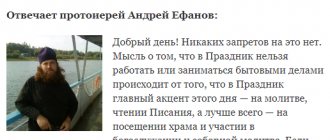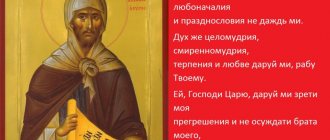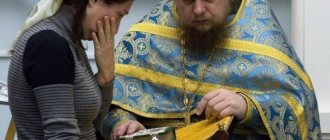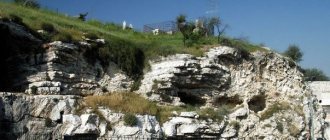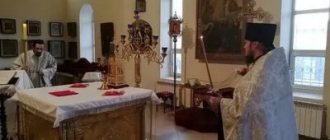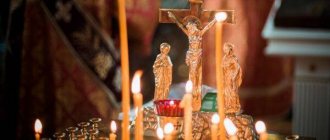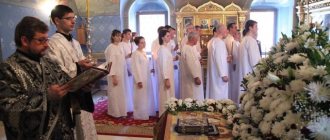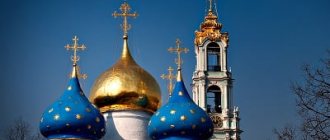What time does the temple open?
Of course, when a service or service is planned, the temple is opened.
But how long has the church been open? It all depends on the parish, the locality, living conditions and even the time of year. Many churches and monasteries in big cities and small villages, in regional centers and settlements in the summer begin work an hour or half an hour earlier than in winter. So, what time can you arrive? Go during the day to the church you want to go to early in the morning. There may be a schedule of services there. If it is not there, contact the candle maker or the priest on duty with a question.
Did you find the schedule? Look at what time the Divine Liturgy begins. As a rule, in monasteries the service begins very early - at 5 or 6 in the morning. But make sure that lay people (people who do not live in the monastery) are allowed into the monastery territory at this time.
In secular churches (not monasteries), services begin later. In big cities, most often at 9 a.m., and in rural churches at 7 or 8.
For example, the Intercession Monastery, where the relics of Elder Matrona are located, is open to believers from 8.00 to 20.00. And the temple in the same area is open from 9.00. Therefore, check the opening hours.
Holy and Great Friday (Royal Hours)
Kiev-Pechersk Lavra. Beginning at 8.00 Holy Cross Church, Refectory Church (find out the exact start time of the service in your church)
Meaning
The order of following the Hours is very ancient. Since apostolic times, monuments of that era point to the 3rd, 6th and 9th hours as the hours at which Christians gathered for prayer. With the onset of the day, in its very first hour, they turned to God singing psalms, which served to establish the 1st hour. At the third hour (in our opinion, at 9 a.m.) they remembered the descent of the Holy Spirit on the Apostles and called on His grace. The sixth hour was dedicated to the memory of the Crucifixion of the Savior, which took place at the same time. The ninth hour - in remembrance of His death on the cross. The service of each hour consists of 3 psalms, troparions and some prayers. The reading of the Gospel and prophecies is also added to the Royal Hours.
At the 1st hour, the Evangelist Matthew narrates how all the Bishops held a council against Jesus to put Him to death and, having bound Him, handed Him over to Pontius Pilate, the ruler (Matthew 27). At the 3rd hour the Gospel of Mark is read about the torment of Christ in Pilate’s praetorium. The 6th hour remembers the crucifixion of our Lord Jesus Christ. 9th hour - His death.
This combination of hours into one whole realizes the main idea of establishing hours as a prayerful glorification of sacred times and dates that marked and sanctified the work of our salvation.
Thus, just as the Liturgy of Maundy Thursday is the Liturgy of all Liturgies, so the Royal Hours of Good Friday can be called the Hours of the Hours.
What time does the church close?
In the evenings before Sunday, and even before major holidays (church holidays), vespers and all-night vigils are served. Until what time is the church open? The service lasts 2-3 hours. Look at the temple schedule or ask the candle maker (the woman who sells candles, icons, utensils, and who takes notes at the counter). For example, the evening starts at 16.00. Most likely, the service will end at 18.00. Then the temple closes.
Some people ask what time church is open on Sunday. And again, we can only say that everything depends on the rector of the temple, the locality and the parish. It happens that in a provincial town the church closes almost immediately after the liturgy ends and the water is blessed (for example, at 11 o’clock). On the other hand, in a big city the temple may remain open until later.
If there is a major church holiday on Monday, then on Sunday evening the church will be open until the end of the service.
When does the blessing of eggs and Easter cakes take place?
The most appropriate time to bless eggs and Easter cakes is the Easter service. The festive service takes place in the church on the night from Saturday to Sunday and ends at approximately three o'clock in the morning.
Of course, for many people this is very late, so there is nothing wrong with coming to the temple not in the evening, but on Easter day and blessing the food. This must be done before noon - after all, the celebration begins early in the morning, and during the day it is better to be at home and congratulate each other with a joyful greeting: “Christ is risen! Truly risen!”
It would be useful to know that consecrated food should not be thrown away. Therefore, you should not take a lot of food in the basket.
When is the best time to go to church?
Many unchurched people believe that it is worth visiting a temple only when there are few people or no one there. It is enough to light a candle, stand, pray a little (about five minutes) and run off about your business. But you really can't do that. In the Gospel, Christ says: “Where two or three are gathered in My name, there I am in the midst of them.” This means that when people pray together as a whole, the Lord accepts such prayers. For this there is a liturgy and an all-night vigil.
Above, we discussed until what time the church is open, but you’d better ask, what time do the liturgy and all-night vigil begin? Believe me, there will be more benefit for the soul if you stay at the service from beginning to end.
Why can the temple be closed permanently?
It happens that no one serves in the church. With what it can be connected? Of course, with the absence of a priest. It is possible that the Diocesan Council is deciding where to find the priest. Another reason is the lack of infrastructure inside the church (lack of an iconostasis, dangerous condition of the building, and so on). Of course, there is no point in asking when the church opens and until what time the church is open in this case.
Well, you and I have considered the issue of the operating hours of Orthodox churches. Unfortunately, there cannot be a single answer to the question posed. After all, each priest sets his own schedule.
Source
What other products can be blessed on the Saturday before Easter?
Of course, believers may be interested not only in when Easter cakes and eggs shine on Easter. People also ask: Can other foods and drinks be illuminated?
The Church does not prohibit parishioners from lighting, for example, meat, wine, and meat products. You can also put salt, seasoning, and a piece of cheese in the Easter basket. You should not take alcoholic beverages for consecration.
The corresponding commentary is given by Hieromonk Job Gumerov:
The tradition of consecrating Easter cakes in the temple allows a person to tune in to the bright waves of the holiday. It is no secret that a special atmosphere develops in a congregation of believers that can hardly be felt at home. That is why you should definitely visit the temple on such a day.
Temple and Cathedral
Please note that churches and cathedrals open at different times depending on
First of all, large city cathedrals often open early and close later than others. The difference between a temple, a church and a cathedral is as follows:
The concept of “temple” means the seat of God, the house of God - that is, a building. Also in the books of the Apostolic Epistles and the works of the Holy Fathers, the human body is called the temple of God, because God’s grace and the Holy Spirit dwell in a believing and pious person who approaches the Sacraments of the Church.
The concept of “Church” is quite broad: it is a building (in this meaning of the word church and temple are one and the same!), and a meeting of all believers, and a regional meeting of Orthodox people - for example, the Russian Orthodox Church, the Greek Orthodox Church.
A cathedral was originally the main temple of a city or monastery. Nowadays such a cathedral is called “cathedral”, and the word “cathedral” simply means a large temple. That is, prominent large temples in cities will be called cathedrals. Also, the Old Russian word “cathedral”, translated as “assembly”, still refers to congresses of the episcopate and lay Christians to this day (for example, the Ecumenical Council is a meeting of representatives of all Orthodox regional Churches, the Local Council is a meeting of one Church).
Vespers and Removal of the Shroud
Then, most often at the third hour of the day, at the hour of Christ’s death, in remembrance of the removal of the body of Christ from the cross, Vespers and the removal of the Shroud are performed.
Kiev-Pechersk Lavra. Beginning at 14:00 — Assumption Cathedral, Refectory Church
Meaning
In the first centuries of Christianity, Holy and Great Friday was called Easter of the Crucifixion or Easter of the Cross, according to the words of the Apostle Paul: “Our Easter is Christ sacrificed for us” (1 Cor. 5:7). Only from the 2nd century did the Easter of the Resurrection, the Easter of common triumph and joy, begin to separate from this Easter.
Good Friday has always been a day of the strictest fasting and sadness, “a day of sorrow on which we fast.” The Apostolic Epistles command those who are able to spend this day in perfect fasting without food. Therefore, on Good Friday, after hours, as a sign of sadness, the Liturgy is not served, but solemn Vespers is celebrated. The beginning of Vespers is timed between 12 and 3 o'clock in the afternoon (that is, between 6 and 9 o'clock, when the crucifixion and death of the Lord Jesus Christ took place). In the middle of the church there is a cross - a crucifix, to which those praying come to venerate. The very first hymns of Vespers take us to the great and terrible moments that took place at Golgotha. What the succession of the Passion was leading to on Friday night is now being fulfilled: “We see a terrible and extraordinary mystery now happening: the Intangible is held; He who freed Adam from the curse is contacted; He who examines (sees through) the hearts and wombs (innermost thoughts) is subjected to an unrighteous test (interrogation); He who closed the abyss shuts himself in prison; Pilate faces the One Who stands before the Heavenly powers with trembling; by the hand of creation the Creator receives a slap in the face; He who judges the living and the dead is condemned to the tree (to death on the cross); in the tomb lies the Destroyer (Conqueror) of hell” (the last stichera on the Lord I cried).
The last dying cry of the Son of God, dying on the cross, pierces our hearts with unbearable pain: My God, be aware of Me, the one you have forsaken Me. The betrayal of Judas, the denial of Peter, the humiliation before Caiaphas, the trial by Pilate and the abandonment of the disciples did not end the suffering of the Son of God. Nailed to the cross, crucified and dying a painful death, He was abandoned by His Heavenly Father. No human word can express this thought: the abandonment of the Only Begotten of the Father by the Son of God. “Without being separated from humanity, the Divine was so hidden in the soul of the Crucified God-Man that His humanity was given over to all the horrors of helpless sorrow” (Archbishop Innocent). True, remaining omnipresent, He was in the grave carnally (flesh), in hell with the soul like God, in paradise with the thief and on the Throne you were, Christ, with the Father and the Spirit, filling everything (filling everything) Indescribable (Unlimited, Ubiquitous). But, despite His omnipresence, His abandonment by God is full of great tragedy, for He, the One of the Holy Trinity, was given the opportunity to experience to the end the entire depth of the underworld and the severity of hellish torment.
The day is approaching evening, and the earthly life of the God-Man is approaching sunset. The entrance is made with the Gospel and somehow the quiet evening song of the Quiet Light (lit. from Greek - pleasant, joyful) is heard in these moments in a particularly comforting way. This Quiet Light, which illuminated the world during Its short earthly life, is now setting. This Quiet Light is the same ineffable light of the Divine that the prophet Moses was privileged to see at Sinai; that unbearable light, after which he had to put a veil over his face, for it shone with rays of glory because God spoke to him. The reading of Exodus speaks of this vision of glory, and the reading of Job that follows again shows the image of Christ in the long-suffering Job, glorified by the Lord for his patience. In the 3rd proverb, the prophet Isaiah prophesies about Christ and gives an image of Him as “a Youth who had neither form nor greatness. His appearance is diminished more than all the sons of men. This one bears our sins and suffers for us. He was wounded for our sins and tortured for our iniquities, the punishment for (the whole) our world was upon Him, and through His suffering we were healed. He is brought to the slaughter like a sheep and like a silent lamb before the shearer, so He does not open His mouth.” Moses and Isaiah enter, as it were, into a spiritual debate, contrasting one with the unspeakable glory, the other with the unspeakable humiliation of the Lord. Both of these extremes are lost in the immensity of the infinite being of God, for the limited human mind is equally incomprehensible as the state of the Lord’s humiliation and His glory.
The Apostle's Prokeimenon proclaims David's prophecy about the death of the Lord and the abandonment of Him by the Father: I have laid Me in the pit of the grave, in the dark places and the shadow of death. And the message of the Apostle Paul is read, resolving the mysterious bewilderment of both prophets and reconciling the glory and dishonor of the Lord with his word about the cross, which is foolishness for those who are perishing, but for... those who are being saved, it is the power of God... because the foolish things of God are wiser than men, and the weak things of God are stronger than men .
Before reading the Gospel, candles are lit and remain lit until the end of the service. The Gospel tells us about the death and burial of the Savior, and the stichera that follows tells about Joseph of Arimathea, who came to wrap a shroud around His most pure Body. And immediately after this, as if news brought from the heavenly world, the verse is heard: The Lord reigns, clothed in beauty. The Lord reigns, although he dies; The Lord reigns, although he descends into hell; The Lord reigns and all-mocking hell (mocking everything) (the next stichera) is horrified at the sight of Him: its shutters are broken, its gates are broken, the tombs are opened and the dead rise, rejoicing. The 2nd and 3rd stichera are dedicated to this mysterious descent of the Lord into hell and His glorification. The last stichera from the highest heights and from the hellish underworld leads us again to the tomb of our Savior. Joseph took him down from the tree with Nicodemus, dressed in light like a robe, and, seeing the dead naked woman unburied, we will accept the compassionate cry, sobbing with the words: Alas for me, sweetest Jesus, Whom the sun, seeing hanging on the cross, was covered with darkness, and the earth shook with fear, and the veil of the church was torn. And now I see You, willingly accepting death for my sake. How will I bury You, my God, and with what shroud will I wrap my arms? With what hands will I touch Your incorruptible body, what songs will I sing to Your exodus, O Generous One? I magnify Your Passion, I will sing songs and Your burial with the Resurrection, crying out: Lord, glory to You; After this song, the clergyman, accompanied by the laity (depicting Joseph with Nicodemus), lifts the Shroud from the Throne and carries it to the middle of the church. During the carrying out of the Shroud, the choir sings the troparion: The noble Joseph took down Your Most Pure Body from the tree, entwining the Shroud with a clean one; and cover the coffin with stinks. At the end of this chant, the Shroud is kissed, around which the breath of angelic wings can already be seen: an Angel appeared to the myrrh-bearing women standing at the tomb, warning them about the incorruption of the Most Pure Body of Christ.
At Compline on Good Friday, which immediately follows Vespers and the Removal of the Shroud, the canon for the Lamentation of the Virgin Mary is read or sung. In it, the Church illuminates the hidden, inner meaning of what the people expressed in the famous folk tale “The Virgin’s Walk through Torment.” In wondrous words, the Church reveals to us that the abandonment of the Son of God by the Father and His descent into hell was shared with Him by His Most Pure Mother. And if history was silent about this and people passed by the Lamb of God, who was ripening the slaughter of Her Lamb, then church poetry today brings to the One whose heart was now pierced by a sharp weapon, the wondrous gift of her songs, a pearl necklace of tears. Troparion of Song 7 says, as if on behalf of the Mother of God: “Take Me now with You, My Son and My God, so that I too may go with You into hell, Master, do not leave Me alone.” “Joy will never touch Me from now on” (troparia of the 9th canto), the Immaculate One said sobbingly. “My light and my joy went into the grave; but not
I’ll leave Him alone, I’ll die here and be buried with Him.” “Heal my spiritual ulcer now, My Child,” the Most Pure One cried with tears. “Resurrect and quench My sorrow - you can do whatever you want, Lord, and do, although you were buried voluntarily.” The Mother of God, who was present with her Son at the wedding in Cana of Galilee and begged Him to turn water into wine, even then believed that Her Divine could create everything
Son, for she said to the servants: “Whatever He tells you, do it.” And now, seeing Him already dead, She knew about the Resurrection of the One about Whom the Archangel Gabriel announced to Her on the day of the Bright Annunciation. And in response to Her faith, “The Lord secretly said to the Mother: “Desiring to save My creation, I wanted to die, but I will rise again and glorify You as the God of heaven and earth.” The canon ends with this mysterious conversation between the Son and Mother.
What time does the temple close?
After the evening service or according to a schedule that needs to be confirmed with the staff.
Solemn evening services - All-night vigils - are held before church holidays, days of revered saints and on Saturday. The name is just a tradition; the service does not last all night, but for about 2-3 hours in different churches.
The all-night vigil begins either at 17:00 or 18:00. Sometimes - in rare cases, in a village, in a remote monastery - at 16:00.
In monasteries, services for both the Liturgy and the All-Night Vigil last longer.
Is it possible to consecrate eggs and Easter cakes at home?
The consecration of eggs and Easter cake in the temple is a solemn preparation for the holiday. Although many people do not come to church, it is right to go to the temple and fulfill the ancient tradition.
Every believer can come to church on Easter, or at least ask a loved one to do it instead. It is important to understand that these products are not just food, but real symbols of the bright resurrection. The egg represents life, rebirth, and the Easter cakes are the image of the body of Christ.
Well, after everything is ready, you can come home and sit down at the table. Usually in churches there is a religious procession at midnight.
Afterwards they solemnly announce that Easter has come, and from that moment on you can eat the blessed Easter food. The holiday begins and Lent ends.
If the church is closed
Sometimes, especially in the provinces, churches are closed most of the time. This is due to the fact that priests and church employees live on donations and part-time jobs (for example, in villages, priests earn extra money as drivers, loaders, and tractor drivers), so they often come only to worship services.
Usually the phone number of the church or priest is either on the wall, or on the website, or in the office of the diocese. Do not hesitate to call the priest if you have a difficult question or need to be baptized, married, or have a funeral service for a loved one.
It also happens that the temple is closed all the time and the priest comes from the city on certain days or the temple is undergoing repairs. If there is no information about this on the stands near the church, call the diocese office.
Time and days of the Liturgy
The Liturgy is celebrated in large churches every day (except for days when it cannot be celebrated), in most others - every Sunday. The Liturgy usually begins at 9–10 a.m.; in churches where there is more than one altar, an early liturgy can also be celebrated (at 6–7 a.m.). Duration of the service (depending on whether it is performed by a priest or a bishop): 1.5–2 hours.
As for the Typikon (Chapter 8: On the Liturgies), it gives the start time of the Liturgy and the time for setting meals on various days (Sat., Sun., holidays). The difference between both is 1 hour.
There will be no liturgy on the following days.
- On Wednesday and Friday of Cheese Week (the week before Lent).
- On Monday, Tuesday and Thursday of the weeks of Great Lent.
- On Good Friday, if this day does not coincide with the Feast of the Annunciation of the Most Holy Theotokos (April 7), when the Liturgy of St. John Chrysostom is scheduled.
- On the Friday preceding the holidays of the Nativity of Christ and the Epiphany, if the holidays themselves fall on Sunday or Monday.
When is the best time to go to temple?
Many people who don’t yet know much about the Church get used to being “goers” - coming in when it’s convenient, lighting candles and not praying during services. However, the Lord Himself speaks about church prayer during general worship: “Where two or three are gathered in My name, there I am in the midst of them.” The original meaning of the word “Church” is a meeting of Christ’s disciples, Christians; translated as “meeting”. It is interesting that the first Christians often gathered not only in buildings; it is important that they were together even in the open air and could perform the Sacraments and pray.
The main service in the church, the main sacrament, is the Liturgy. The most powerful prayer is any commemoration of a person during the Liturgy and, of course, communion itself. The whole Church prays for a person during the Sacrament of the Eucharist.
After the words of Christ: “Take and eat: this is My Body and My Blood,” - by the grace of the Savior, bread and wine, having their former appearance, then ceased and cease now at every Liturgy to be earthly things. They become, according to the Gospel word, bread, that is, the food of life - the Flesh of Christ, which He gives for the forgiveness of all human sins. By receiving communion, people receive great strength and grace from God.
The Church blesses us to receive communion at least once a year: preferably about once a month.
How does the rite of consecration take place?
There is a legend why the main gifts for Easter are Easter cakes and eggs. The tradition of placing holiday bread at the head of the table has been around since Jesus sat down to eat with his disciples. And eggs from the time of Mary Magdalene. She, preaching Christianity, reached the Emperor Tiberius himself. But it was impossible to go to him empty-handed, and she only had a basket of eggs. Having heard about the resurrection of Christ, the emperor expressed skepticism that the eggs would sooner turn red than this would happen. And then the shell changed color to purple.
Sprinkling occurs as follows. Tables are set up in the temple where prepared gifts are laid out. In courtyards, people place them on bags or newspapers, if the priests haven’t thought about benches. Once every 30-40 minutes, the priest goes around the believers with a censer, sprinkling the food with Holy water.
At this time he sings the troparion: “Christ is risen from the dead, trampling down death by death. And he gave life to those in the graves.” The chant is periodically interrupted by the exclamation “Christ is risen!” The Orthodox, in response, must cross themselves and confirm: “Truly he is risen!” It is not customary to kiss in church, much less approach the priest.
Interesting!
There is no need to stick a candle into the Easter cake when blessing it. The flame can go out from the wind or from a draft in the church. Many people consider this a bad omen, and the residue remains for a long time. In fact, this does not mean anything, but still you should not give impetus to bad thoughts.
Some of the gifts need to be placed in a basket - it stands in the church or is carried by the minister. You can simply give the treats to the poor.
How to behave correctly in the temple
Upon entering the temple, you will see in front of the icons special gilded candlesticks for many thin candles and several thick ones. They are located in front of most icons, as well as near the icon lying in the center of the temple on a separate inclined table - a lectern (this will be an icon of a saint or an event whose memory is celebrated on this day, or an icon of the Resurrection of Christ).
Most often, candles are first purchased from a church store. The first candle is placed on the central candlestick in the temple, saying to oneself: “Lord, bless! Most Holy Theotokos, save us!” After setting the candles, they cross themselves and bow to the altar.
They also place candles in front of any icons, the saints depicted on which you want to pray.
Approach your chosen icon at any distance. Cross yourself, say: “Bless, Lord (or – Mother of God, or – saint...).”
Tilt it towards a lamp or, better yet, (lamps have short wicks and can go out on contact) towards someone else’s candle, light it from the fire. Try not to drip wax into the lamp.
Bring the other end of the candle to the fire to soften the wax and immediately place the candle in the chosen place on the candlestick.
Cross yourself again, looking at the icon, and bow.
Now you can read the prepared prayer or pray in front of the image in your own words. Read the prayer with attention, remain in communion with God, the Mother of God or the saints, address them as if they were alive. Tell us in your own words about trouble and sorrow, ask for help.
After prayer, you can kiss the icon according to tradition - this is called “kissing the icon”: cross yourself twice, kiss the hand or the edge of the clothing of the image on the icon, cross yourself again.
It is better not to light candles during services. Look at the situation, get baptized together with other people, bow down. In the temple, no one will especially watch you.
Products unsuitable for consecration in church
Many adults, in order to bring joy to children, place chocolate eggs or other figures and candies in a basket along with colored eggs. It is undesirable to do this, although there is no clear prohibition. It is strictly forbidden to consecrate alcohol, including red wine. This is done separately.
Attention!
Perhaps the priest of a particular church allows Cahors to be brought to the service, but this is wrong.
A categorical ban on products that contain blood: blood sausage, hematogen, medicinal bread for anemia. This is stated separately in Holy Scripture.
What time does it open, until what time is the Church of the Matrona of Moscow open?
One of the most revered Russian saints is Matrona of Moscow. Matronushka, blessed Matrona, Saint Matrona of Moscow - all these are the names of one saint, revered by the entire Orthodox Church, beloved and dear to Orthodox Christians around the world. The saint was born in the 19th century and died in 1952. There are many witnesses to her holiness who saw Matronushka during her lifetime. Even today she helps those who pray; there are many testimonies about miracles after prayers in front of her icons and relics and about the appearances of the blessed Matrona in dreams to believers.
There is a pious Orthodox tradition of writing notes to Saint Matrona - like personal letters. It is known that there are prayers to the Matrona of Moscow, and simply in your own words you can ask Matronushka for help. However, according to tradition, you can write notes, examples of which you will see, and put them behind the icon in the temple or to the relics of the saint.
There is a tradition of praying for help to the Matrona of Moscow at her relics in the Pokrovsky Monastery at the Pokrovskaya (Abelmanovskaya) outpost in Moscow. This place is also known as the temple or monastery of the Matrona of Moscow on Taganka.
The relics and the monastery are open from 8:00 to 20:00 at the address: Moscow, st. Taganskaya 58. You can get to the monastery by ground transport or by metro.
It is known that there are reference sites about Saint Matrona, but the notes and comments on the Internet are not true letters from the saint. A visit to the temple or the Intercession Monastery, where the relics of Matrona reside, will become your pilgrimage, a small labor as a sign of your desire to be heard.
There is a tradition of going to Matronushka for help with flowers - a living offering to her, evidence of the sincerity of your prayer and love for the saint. You will definitely feel that Matrona of Moscow becomes like family to you, as for many people - that’s why she is affectionately called Matronushka. In the Pokrovsky Monastery there are always many bouquets of fresh flowers around the shrine (tomb) with the holy relics of the blessed one. Often priests give their blessing to take flowers laid by other people who are seriously suffering and ill as a gift from the Matrona of Moscow herself.
If possible, purchase an odd number of roses - the saint loved them during her lifetime - place them near the image or at the relics.
Buy church candles and before the image of the blessed one in the temple, read the prayer according to the text below. Talk to her as if she were alive - that’s what she asked herself.
May the Lord bless you with His grace!
Source
When to bless Easter cakes and eggs for Easter in 2022
It is advisable to do this on Saturday. The ritual begins in the morning, from 11-12 o'clock, and continues until 20-21 o'clock. Next, the clergy begin preparing for the night service, the time of the sacrament. In some parishes and during it, the priest has time to sprinkle the gifts with Holy water.
In small churches, the ceremony is usually held outside. Worshipers with gifts line up in a circle or line up in the temple courtyard, and the priest comes out and sprinkles the supplies in batches.
Important!
Due to the coronavirus epidemic and the high probability of infection in crowded places, in 2022 it is recommended that clergy of all churches bless gifts on the street.
Those who did not have time to visit church on Saturday are not forbidden to do so on Easter Sunday, but preferably before noon. And if it is absolutely impossible to go to church, Orthodox Christians are allowed to carry out the ceremony with gifts on their own.

